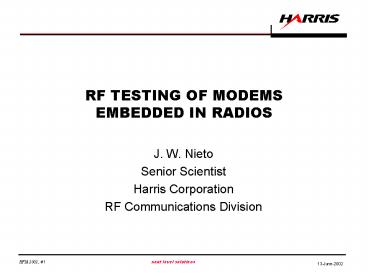RF TESTING OF MODEMS EMBEDDED IN RADIOS PowerPoint PPT Presentation
1 / 13
Title: RF TESTING OF MODEMS EMBEDDED IN RADIOS
1
RF TESTING OF MODEMS EMBEDDED IN RADIOS
- J. W. Nieto
- Senior Scientist
- Harris Corporation
- RF Communications Division
2
Presentation Overview
- Overview
- Motivation
- Baseband Testing
- RF Testing
- RF Test Setups
- Recommendations
- Summary
3
Motivation
- Most HF waveform standards define a set of
minimum performance requirements which must be
met in order for a modem to be compliant with the
standard - These performance requirements have been
determined using a baseband HF channel simulator - STANAG 4539 3200-12800 bps adds baseband radio
filters (digital filter taps provided in STANAG) - If minimum performance numbers have no margin,
demodulation process may meet performance specs
when tested at baseband but not when embedded in
radios
4
Motivation
- Differences between baseband testing and RF
testing - Transmit Side
- Transmit radio filter
- Transmit Gain Control (TGC)
- Automatic Level Control (ALC)
- Receive Side
- Receive radio filter
- Automatic Gain Control (AGC)
- To complicate things further, radio manufacturers
will likely implement all of the above differently
5
Motivation
- Example US MIL-STD-188-110B Appendix C 12800 bps
waveform utilizing radios with poor AGC
characteristics (e.g. too fast) - 12800 bps is 64-QAM constellation with no
coding/interleaving - Waveform will run with errors even in a noise
free environment - BER will never be less than 1e-5 at any SNR !
- Will fail certification !
- At baseband, same demodulation process likely
exceeded performance requirement of standard
6
Motivation
- Why did modem fail at RF ?
- AGC causes sudden changes in amplitude of
waveform. Since amplitude contains information
for M-QAM constellations, errors have been
introduced - TGC and ALC can drive signal too high into Power
amplifier, distorting signal and possibly
modulating signal. This effectively limits the
maximum SNR measured at the demodulator and may
cause bit errors - TX and RX radio filters spread impulse response
of system. Demodulator process has to use more
taps for channel estimate which allows more noise
into system. Typical radio filter losses between
1-3 dB
7
Baseband Testing
- Goal of testing Repeatable and comparable
long-term BER modem performance measurement - HF Channel Simulator
- Watterson Model
- Mechanism for simulating fading characteristics
very important for achieving repeatable and
comparable results - No radio filters or known (specified) digital
radio filters - No TGC, ALC, or AGC
- Signal to Noise Ratio (SNR) is average long-term
SNR of waveform in 3 KHz - For 110B Appendix C and F Waveforms, SNR
calibration may require several minutes - Test should ignore first few minutes of results
in order to avoid Acquisition related bit
errors (specially in fading channels)
8
RF Testing
- RF setup extremely important
- Improper setup can limit SNR of system with no
noise (RX SNR must be checked !) - If possible, TGC and ALC should be turned off at
transmit end - Test should be performed at low power with enough
attenuation between radios - Slowest AGC setting should be selected for RX
radio - If AGC is turned off for RX radio, RF level into
radio must be carefully selected
9
RF Test Setup 1
Baseband
RF
MODEM
X
RADIO 1
BER TESTER
Synthesizer
HF_SIM
X
RADIO 2
RF
10
RF Test Setup 2
Baseband
MODEM
HF_SIM
BER TESTER
Radio 1
RF
11
RF Test Setup
- RF Test Setup 1 (Traditional)
- Using low-cost mixers, maximum SNR achievable
close to 30 dB but very sensitive to input/output
signal levels at both mixers - Reliable BER measurements up to 20 dB unless SNR
in channel simulator is selected based on
combined channel simulator and setup SNR (For
example, if max SNR 30 dB and the channel
simulator is set to 30 dB SNR, effective SNR is
27 dB, 3 dB off from desired point) - RF Test Setup 2 (courtesy of JITC _at_ Fort
Huachuca) - Maximum SNR achievable gt 40 dB
- Radio 1 should have TGC and ALC disabled (or
preferably, an exciter with no PA is used) - Reliable BER measurements gt 30 dB
12
Recommendations
- Overall testing strategy needs to be defined
- Standards should
- Have performance specifications for baseband
testing and for RF testing - Provide more details on how testing should be
done for baseband testing and RF testing - Specify characteristics of HF channel simulators
- Provide details on how HF channel simulators
characteristics can be verified - Provide details on how calibration for proper SNR
should be done
13
Summary
- Modems which are embedded in radios suffer more
performance losses than modems tested at baseband - HF waveform standards currently dont address
this issue which can result in embedded modems
not meeting performance requirements with same
demodulation process that meets performance at
baseband - HF waveform standards should provide more detail
as to how testing should be done - HF waveform standards should provide more detail
about channel simulator calibration, generation
of fading characteristics, noise, filtering, etc

